You are what you eat, but what you eat doesn't only impact you.
Our World in Data, a nonprofit research firm in the United Kingdom, recently released a study focusing on which foods have the biggest and smallest carbon footprints and what parts of the total food-making process contributed the most to their overall emissions from the farm to the market.
The study looked at factors such as land-use change (like deforestation), farming (like methane emissions), animal feed, processing, transportation and retail energy usage. Surprisingly, transportation made up the least amount of CO2 emissions, while farming and land use were the biggest culprits.
Food production has a long history, and the future of food is changing. Here's what you need to know to make healthy food choices and help reduce the carbon footprint of your diet.
29. Nuts
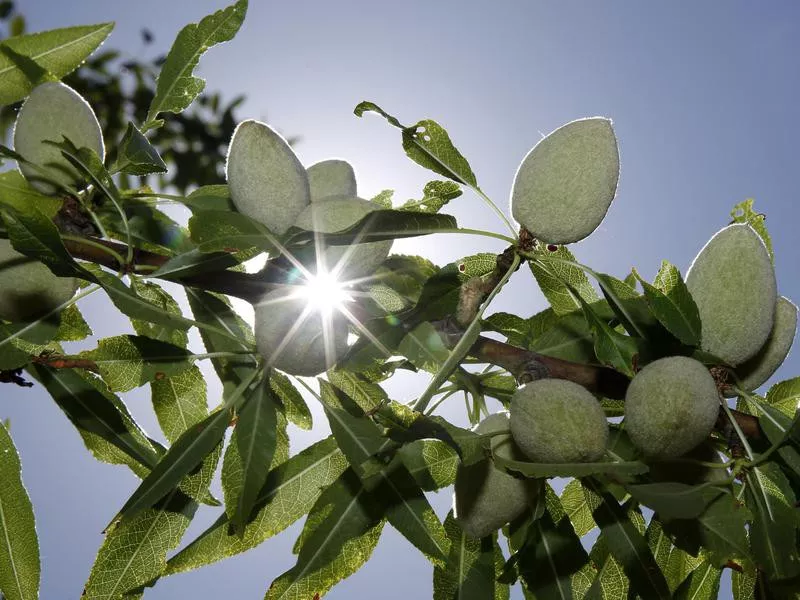
Almonds growing on the branches of an almond tree in Modesto, California. Rich Pedroncelli / AP Photo
Greenhouse gas (GHG) emissions: 0.3 kilogram CO2-equivalents per kilogram of product (kgCO2e)
Type of food: Nut
Biggest producer: In the United States, most nuts (not including peanuts, which is a groundnut) are grown in California. The state exports 67.5 percent of all almond exports worldwide.
Avg. price per unit of snack nuts: $4.58, according to Statista.
Historical origin: The earliest evidence of human nut consumption dates back 780,000 years in Israel. Archaeologists found ancient wild almond, water chestnut, prickly water lily, pistachio and acorn shells that had been cracked open.
Did you know: The biggest single walnut farm in the world is located in a Kyrgyzstan mountain village called Arslanbob. Almost every one of the town’s 16,000 people depends on the sprawling walnut forest for work. Kyrgyzstan exported 1,200 tons of walnuts in 2016. But that’s nothing compared to California, which produced 565,000 tons of walnuts in 2014.
Note: All GHG numbers come from Our World In Data, which has found that 25 percent of the world's greenhouse gas emissions come from food production.
Bottom Line for Nuts
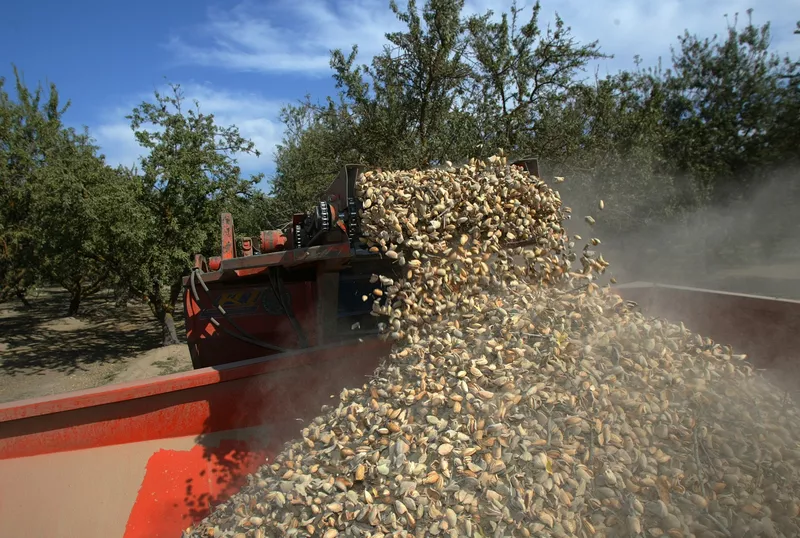
Almonds are dumped after being scooped up in an orchard at a ranch near Fresno, California. Gary Kazanjian / AP Photo
In America, the most common nuts sold are almonds, and walnuts, and 90 percent of all nuts produced in the country come from California. In general, nuts have a negative land-use change figure because the benefit of nut trees outweighs the carbon emissions produced from farming.
However, nuts are thirsty — almonds require about 1,900 gallons per pound. But whether or not that figure is accurate or if it matters when comparing almond farming to any other food farming (it gets complicated) is up for debate.
28. Citrus Fruits
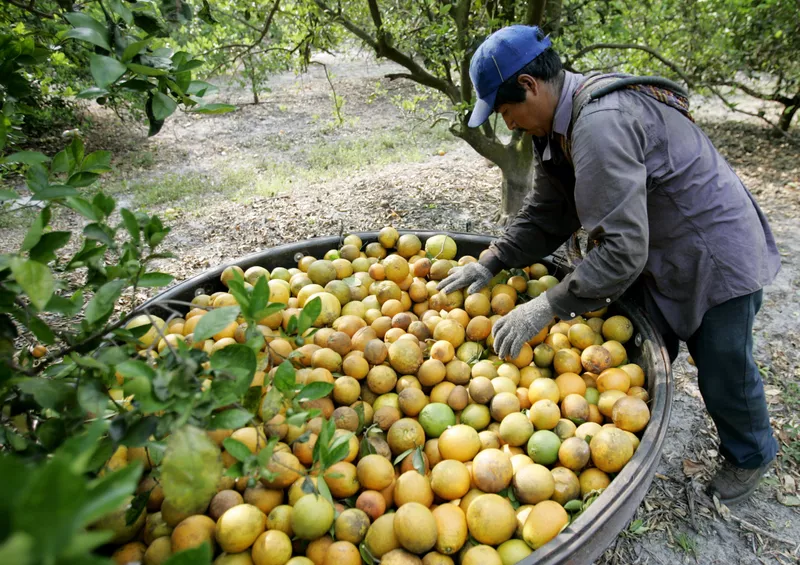
A worker at a citrus farm in the Central Florida town of Arcadia. Lynne Sladky / AP Photo
GHG emissions: 0.3 kgCO2e
Type of food: Fruit
Biggest producers: Brazil, China and United States
Where it’s produced today: Worldwide, Brazil produces the most oranges. In the U.S., Florida is the country’s biggest producer.
Avg. price per pound of oranges in U.S.: $1.33
Historical origin: According to The Verge, modern citrus trees are derived from 10 ancestral species from the southeast foothills of the Himalayas.
Did you know: Florida produces about 97 million boxes of oranges per year.
Bottom Line for Citrus Fruits
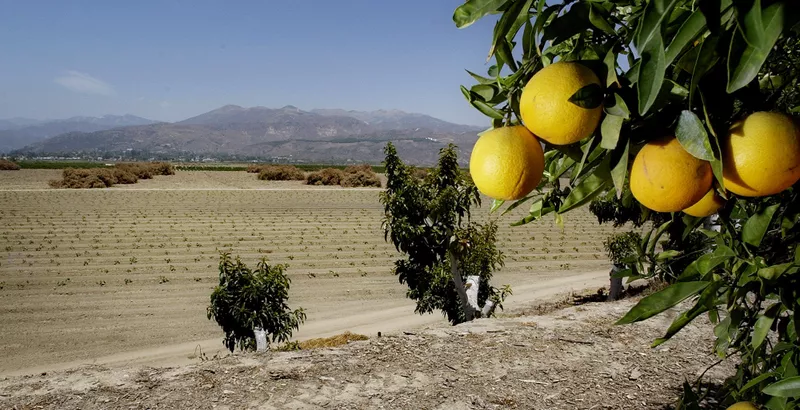
Valencia oranges on a tree in Fillmore, California. Reed Saxon / AP Photo
Citrus fruits are a broad category, but in general, citrus fruit farming emits very low carbon emissions.
Brazil, China and the United States are the top exporters of oranges, grapefruits, lemons, limes and tangerines. Brazil produces the largest amount of orange juice, and Florida is second, although it is the leading producer of grapefruit.
If you’ve had a glass of orange juice and live in America, there’s a 90 percent chance that juice came from the Sunshine State.
27. Apples

An apple orchard near Pullman, Washington. Ted S. Warren / AP Photo
GHG emissions: 0.4 kgCO2e
Type of food: Fruit
Biggest producers: China, United States and European Union
Avg. price per pound of Red Delicious apples: About $1.30
Historical origin: The wild Malus siversii from the mountains of Kazakhstan is the ancestral species to the modern-day apple, according to National Geographic.
Did you know: Apples come in all shapes and sizes and can be bigger than you might imagine. The largest apple in the world was grown in Hirosaki City, Japan, in 2005. It weighed four pounds, one ounce and holds a Guinness World Record for being the world’s heaviest apple.
Bottom Line for Apples
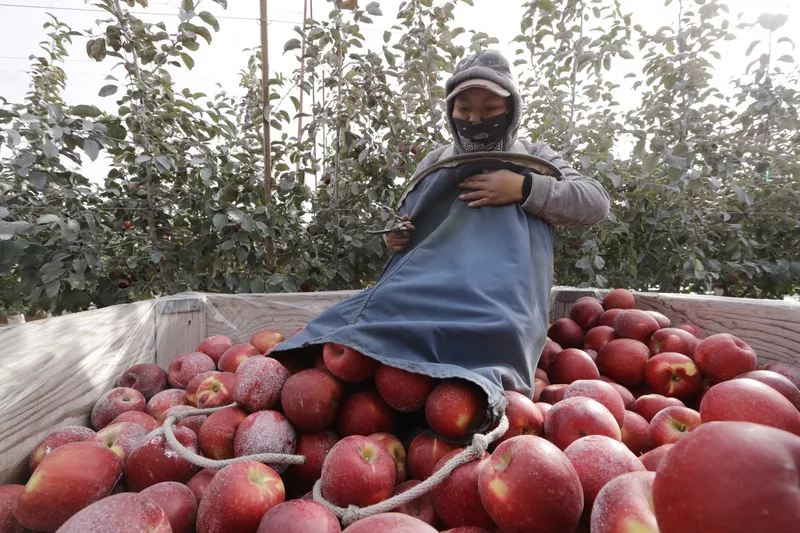
A picking bag full of Cosmic Crisp apples in Wapato, Washington. Elaine Thompson / AP Photo
In 2018, China produced the most apples in the world, with approximately 31 million metric tons of apples. That’s over double the European Union, which produced 14 million apples.
The United States came in third with 5.7 million metric tons. Over 24 million cartons of American-produced apples were Red Delicious apples.
26. Root Vegetables
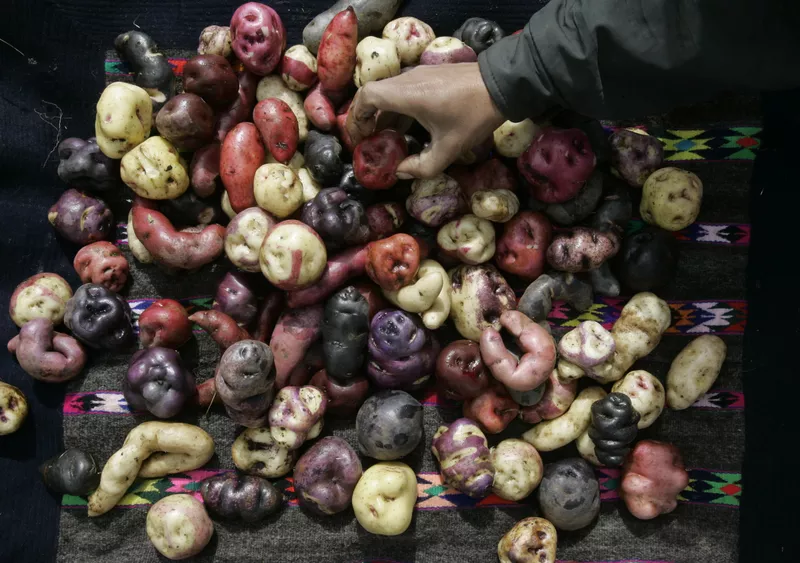
Potatoes after a harvest in Huancavelica, southern Peru. Martin Mejia / AP Photo
GHG emissions: 0.4 kgCO2e
Type of food: Vegetable
Biggest producers: China, India and Russia
Avg. price per pound of potatoes: About $0.78, according to Statista.
Historical origin: Potatoes, the most popular root vegetable, have their roots dating back to the ancient Andean people, who domesticated the crop 8,000 years ago.
Did you know: In the 1860s, the potato beetle wreaked havoc on American potato growers. One farmer, desperate to stop the crop-destroying bug, tossed some leftover green paint — paint he was using to paint his shutters — on some infested potato plants. It worked. The paint, called Paris Green, is considered the forefather of chemical pesticides. It was highly toxic.
Bottom Line for Root Vegetables
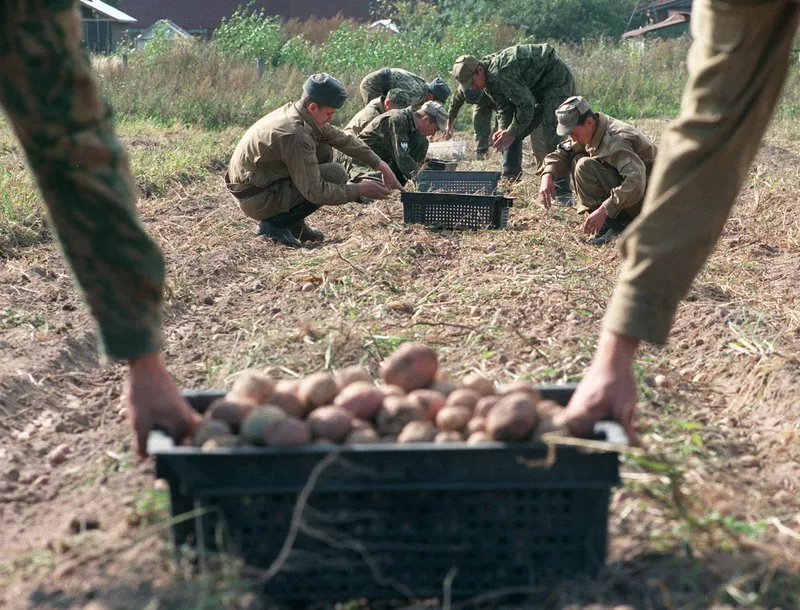
Russian soldiers pick potatoes at a collective farm called "Lenin's Ray of Light" in Ilyinskoe. Peter Dejong / AP Photo
Root vegetables are a wide category, which includes tubers, ginger, turmeric and turnips. But the biggest root vegetable of them all is the humble potato.
America is the fifth-largest potato producer with 20 million tons of the vegetable produced in 2017. That pales in comparison to China, which produced 99.2 million tons.
25. Bananas
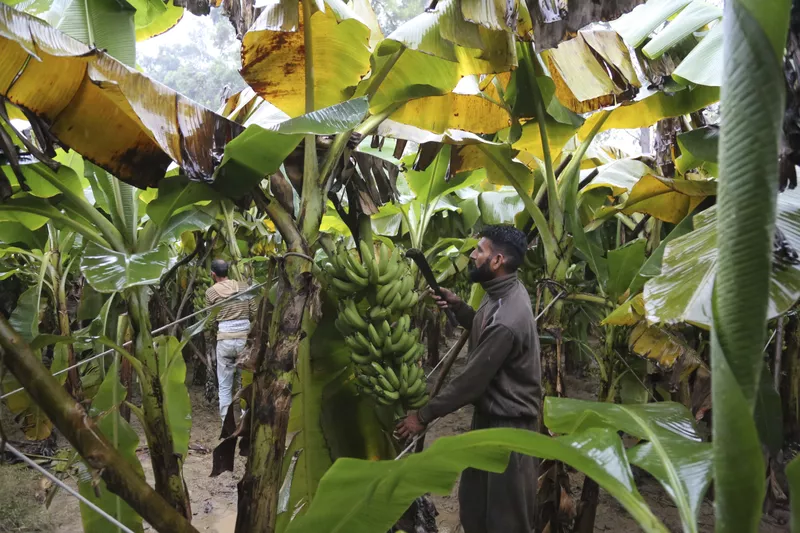
A farmer works at a banana plantation on the outskirts of Jammu, India. Channi Anand / AP Photo
GHG emissions: 0.7 kgCO2e
Type of food: Fruit
Biggest exporters: India and China
Avg. price per pound of bananas in America: $0.57
Historical origin: The banana is believed to be the first fruit cultivated by humans. Experts believe we started cultivating the fruit around 8,000 to 5,000 B.C. in Southeast Asia and the South Pacific, according to Make Fruit Fair.
Did you know: India is the largest producer of bananas. In 2017, the country produces an average of 29 million tons of the fruit each year.
Bottom Line for Bananas
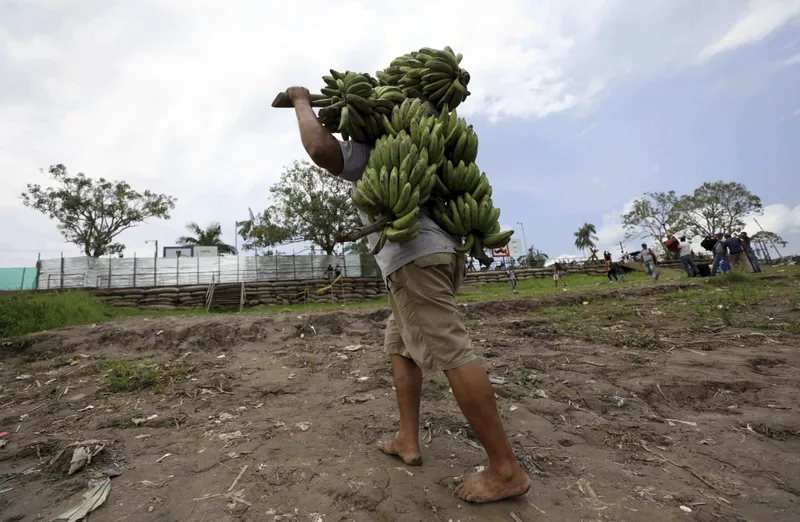
A man carries bananas, unloaded from a boat on the Amazon River in Leticia, Colombia, near the border with Brazil and Peru. Fernando Vergara / AP Photo
While banana farming produces a low amount of carbon emissions, there’s more to it than that. The banana is the world’s most popular fruit, and its demand fuels the need for more and more banana farms, which causes deforestation, water pollution and the spread of pesticides in the rainforest, according to Business Ethics.
24. Peas
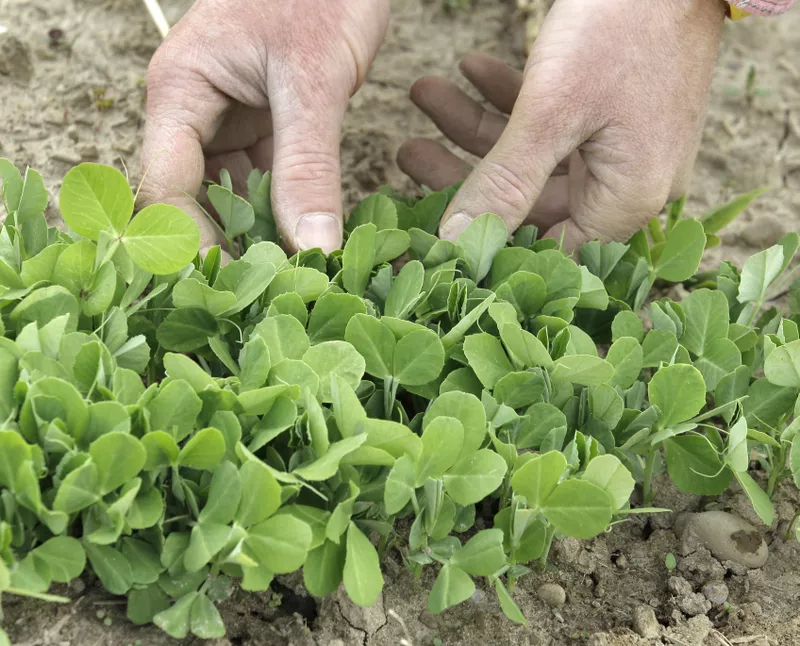
A farmer inspects the growth of a crop of young snap peas in Hiram, Ohio. Amy Sancetta / AP Photo
GHG emissions: 0.9 kgCO2e
Type of food: Vegetable
Biggest producers: Canada and Russia
Avg. price for a pound of peas: About $4.72
Historical origin: The oldest evidence of human pea cultivation dates back 11,300 years ago. Evidence of ancient pea farming was found at the site of Jerf el Ahmar in Syria.
Did you know: Food manufacturers are serious about peas. One Silicon Valley-based business, Ripple Foods, offers pea milk.
Bottom Line for Peas
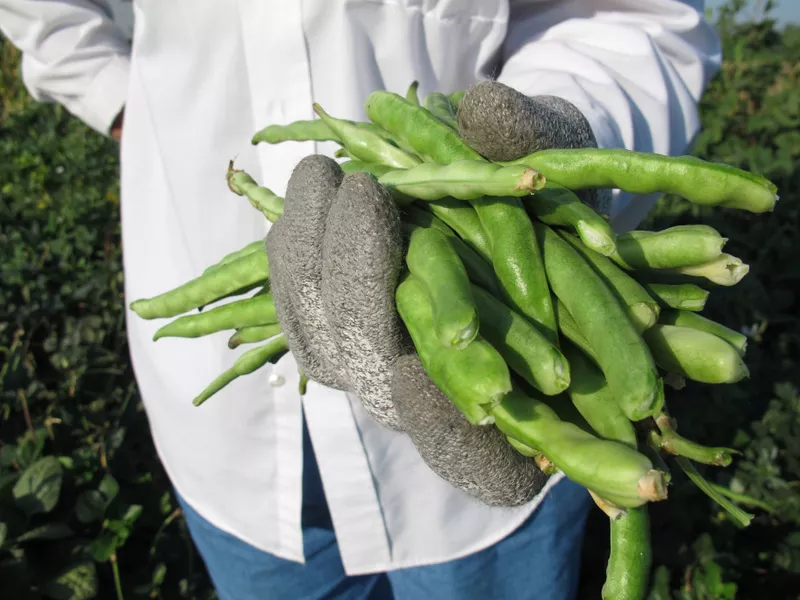
Black-eyed peas in Fresno, California. Gosia Wozniacka / AP Photo
Expect pea production to increase as the demand for protein-rich, vegetable-based foods rises. The pea protein market is expected to triple in size by 2025 and expand to a market worth of $385.7 million by 2027. Cargill is betting on it.
23. Soy Milk
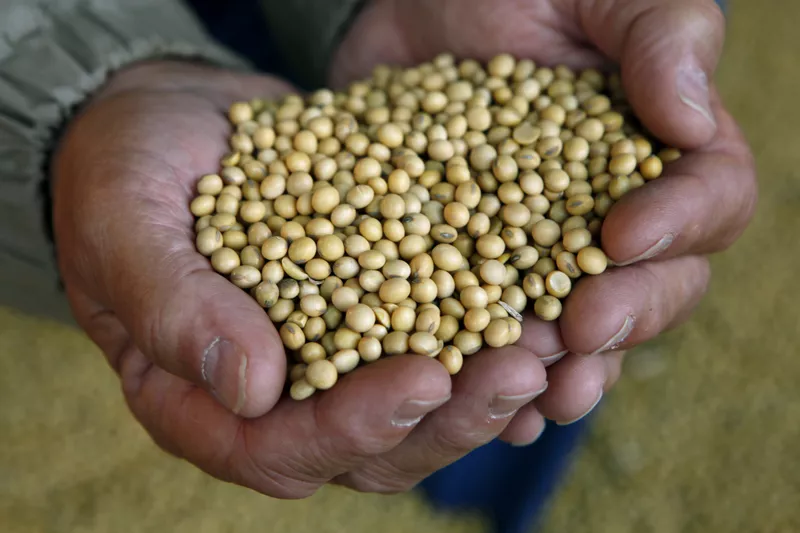
A farmer holds soybeans near Jefferson, Iowa. Charlie Neibergall / AP Photo
GHG emissions: 0.9 kgCO2e
Type of food: Dairy alternative
Biggest producers: United States and Brazil (soybeans)
Avg. price of a half-gallon of soymilk: Costs vary, although Silk, the most popular soymilk in the United States, sells for about $4 per half gallon.
Historical origin: The first mentions of soy milk had to do with the runoffs of making tofu in the late 1800s. It wasn’t until inventor Li Yu-Ying, a Chinese man working in Europe, filed a U.S. patent for "soja milk" in 1911. A translation in an American magazine referred to it as "soya milk," and later, a Frenchman filed a patent referring to "soy milk" and "soy bean milk," according to the Soy Info Center.
Did you know: The global soy milk market value amounted to $15.33 billion in 2018. The market is expected to increase to about $23.2 billion by 2025.
Bottom Line for Soy Milk

Workers on tractors harvest soybeans in Campo Novo do Parecis in the Brazilian state of Mato Grosso. Maurilio Cheli / AP Photo
Getting soybean milk produced from American soybean farms might be guilt-free, but that isn’t the case in Brazil. The country is set to overtake the United States as the world’s largest soybean producer, and that’s not good news for the rainforest. Soybean farming is a major driver of deforestation.
22. Cassava

A Sarayaku Indian woman prepares a traditional drink called "chicha," a special beverage made of yuca that is prepared for celebrations, in a Sarayaku village in Ecuador. Dolores Ochoa / AP Photo
GHG emissions: 1 kgCO2e
Type of food: Root vegetable
Biggest producers: Nigeria, Thailand, Indonesia and Brazil
Avg. price of cassava: Frozen cassava can be found at Walmart at the price of $8.48 for five pounds.
Historical origin: Humans first domesticated cassava, also known as yuca, 8,000 to 10,000 years ago in southern Brazil and eastern Bolivia.
Did you know: Cassava is the third most important source of calories in the tropics. Cassava also can cause cyanide poisoning if not prepared correctly.
Bottom Line for Cassava
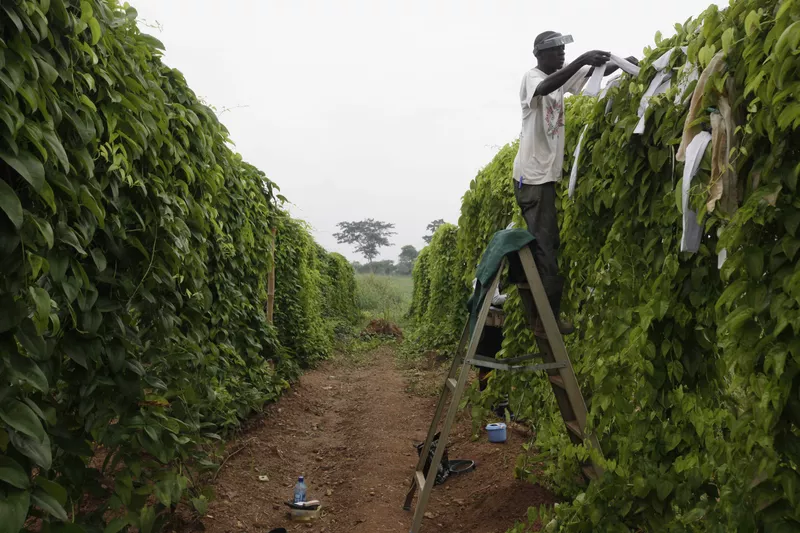
Cassava plants in Ibadan, Nigeria. Sunday Alabama / AP Photo
Cassava is vital to Africa, and is expected to be important for food security as the country’s population is expected to double by 2050. Luckily, the emissions produced by cassava farming are quite low.
21. Maize
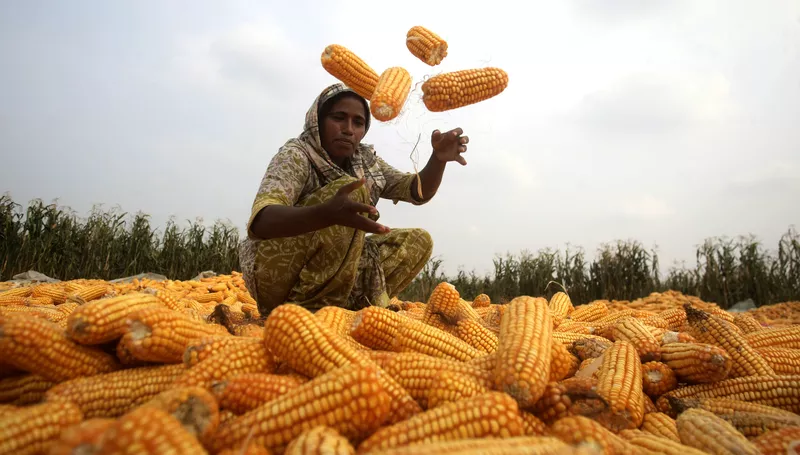
A Pakistani farmer sorts corn in a field in the suburbs of Lahore, Pakistan. K.M. Chaudary / AP Photo
GHG emissions: 1 kgCO2e
Type of food: Vegetable
Biggest producers: United States, China and Brazil
Avg. price: $.50 for a 15-oz can of corn at Walmart.
Historical origin: The earliest evidence we have of corn harvesting traces back 10,000 years in Mesoamerica.
Did you know: The ancients liked popcorn, too. Scientists have dated popped corn kernels found in a cave back 5,600 years.
Bottom Line for Maize
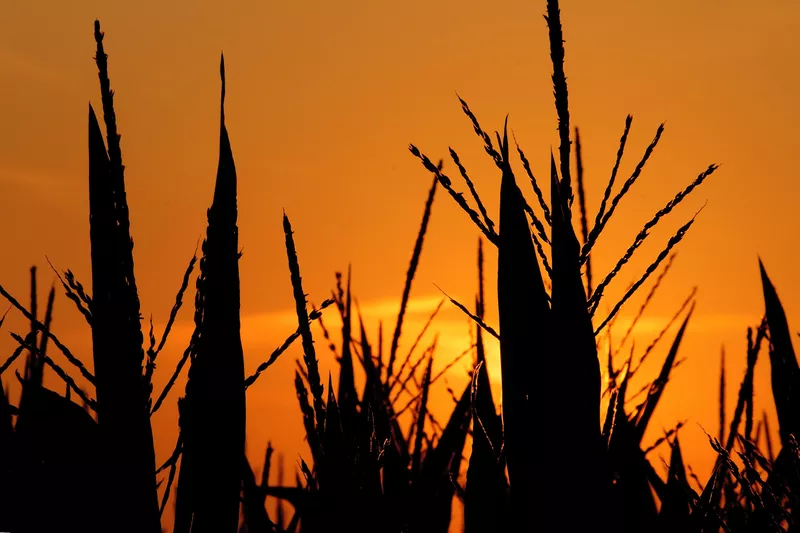
Corn in Pleasant Plains, Illinois. Seth Perlman / AP Photo
America is the world’s biggest producer of corn, with farmers producing 366.3 million metric tons in 2018-2019.
Corn isn’t too sustainable, though. It saps up nitrogen and other nutrients from the soil and requires a lot of water.
It’s also not a very hardy crop. If the world gets hotter, corn yield is expected to decrease, according to Modern Farmer.
20. Tomatoes
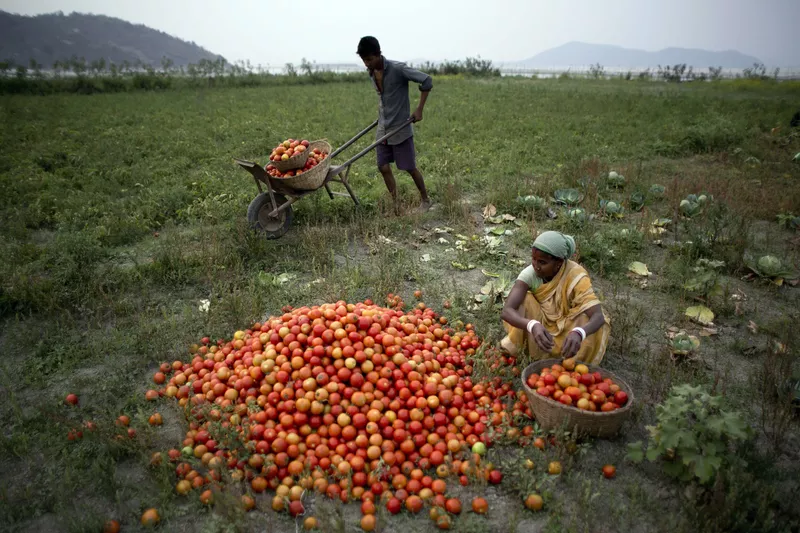
Indian farmers harvest tomatoes at a farm along the River Brahmaputra on the outskirts of Gauhati, India. Anupam Nath / AP
GHG emissions: 1.4 kgCO2e
Type of food: Fruit
Biggest producers: China, Turkey, Italy and Spain
Avg. price per pound of tomatoes: $1.95
Historical origin: Tomatoes were first cultivated by the Aztecs and Incas as early as 700 A.D., although they originated in the Andes.
Did you know: In the 1700s in Europe, people thought tomatoes were poisonous and killed aristocrats. It was actually the high lead content in their highfalutin pewter plates. The acidic tomato juice sopped up the lead.
Bottom Line for Tomatoes
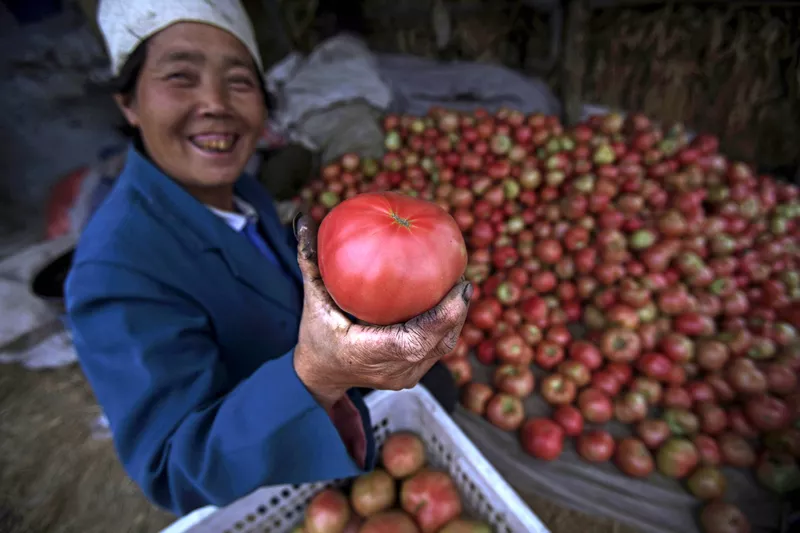
A Chinese farmer packing tomatoes in boxes to be sold on the outskirts of Beijing. Muhammed Muheisen / AP
China produces an incredible amount of tomatoes — it produced one-third of all tomatoes in the world in 2014 — but it mainly uses them domestically or exports them to Russia.
The countries that export the most tomatoes are Mexico and the Netherlands, which accounted for nearly 44 percent of all tomato exports in 2018.
19. Wheat and Rye

A Palestinian farmer harvests wheat on a farm near the West Bank city of Jenin. Mohammed Ballas / AP Photo
GHG emissions: 1.4 kgCO2e
Type of food: Grain
Biggest producers: China, India and Russia
Avg. price: White all-purpose flour costs about $0.43 per pound.
Historical origin: Wheat cultivation traces back 10,000 years to the origins of agriculture itself. Evidence of plant domestication, including wheat, originated from the Fertile Crescent in western Asia.
Did you know: China produces about 134.3 million tons of wheat each year. However, the United States is the world’s leading exporter of wheat.
Bottom Line for Wheat and Rye
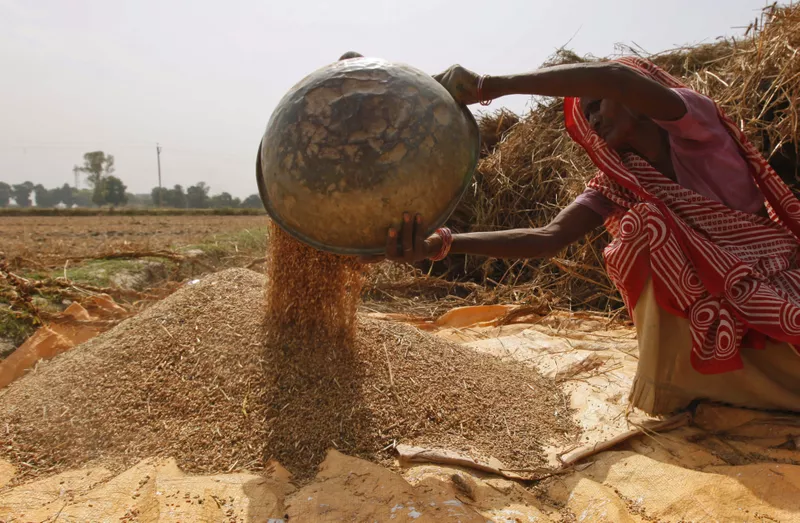
An Indian farmer cleans a wheat crop after harvest on the outskirts of Allahabad, India. Rajesh Kumar Singh / AP Photo
Wheat has a relatively low land-use change, and most of its emissions come from fertilizers, manure and farming equipment.
Wheat can also serve a function in sustainable agriculture. In the American Southwest, Desert Durum grain, used in rotation with vegetable farming, "maximizes economic productivity of water use" while increasing farmer profits, according to the U.S. Sustainability Alliance.
18. Peanuts
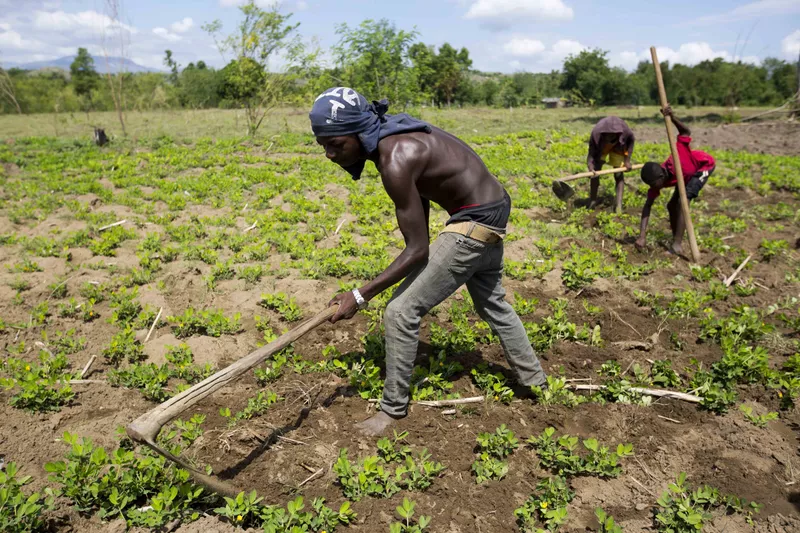
Workers on a peanut farm in Mirebalais, Haiti. Dieu Nalio Chery / AP Photo
GHG emissions: 2.5 kgCO2e
Type of food: Legume
Biggest producers: China and India
Avg. price: About $50 for 25 pounds of jumbo raw shell peanuts at Nuts.com.
Historical origin: It is theorized that peanut consumption originated in South America and was spread throughout the world by Spanish explorers. Peanuts, or groundnuts, were introduced to North America via slave ships in the 1700s, according to the American Peanut Council.
Did you know: George Washington Carver discovered over 300 uses for the peanut, including peanut sausage and peanut shaving cream.
Bottom Line for Peanuts
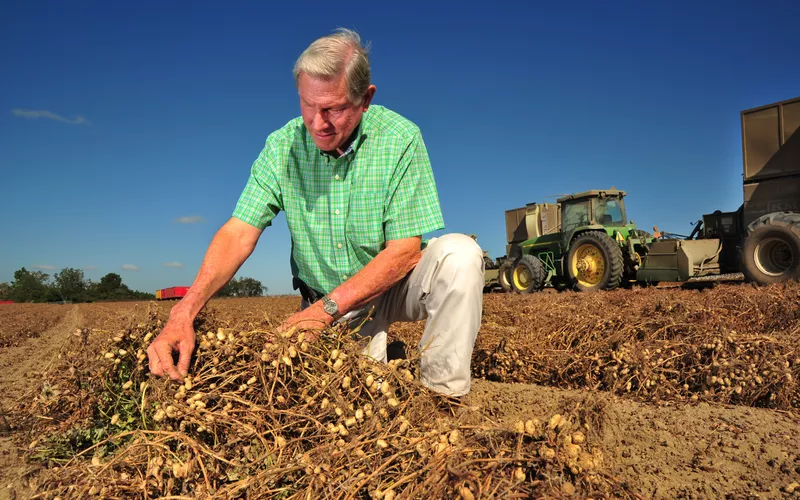
A peanut grower examines peanuts ready for harvest at his Irwinville, Georgia, farm. Todd Stone / AP Photo
Peanuts are a useful rotation crop and release nitrogen into the soil, making them a pretty sustainable crop for farmers.
They also require far less water to grow than above-ground nuts like almonds.
17. Cane Sugar
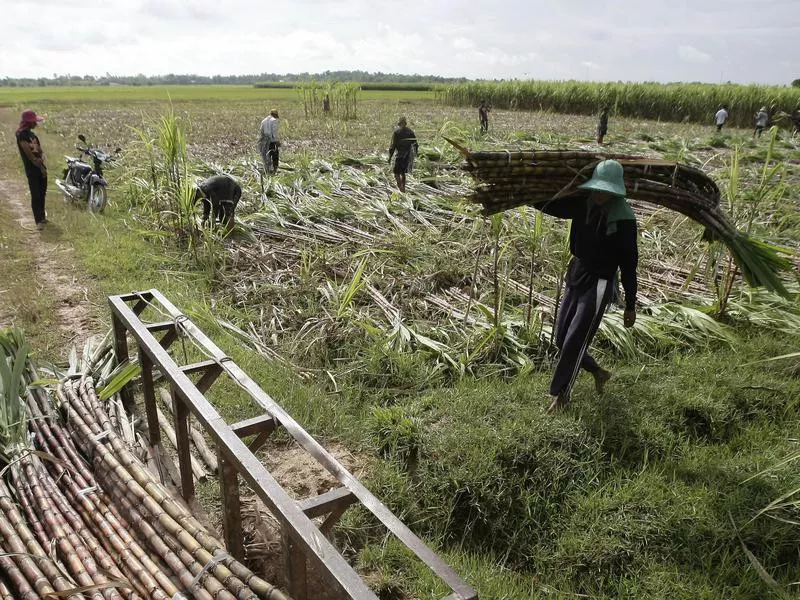
A local worker carries fresh-cut sugarcanes in Cambodia. Heng Sinith / AP Photo
GHG emissions: 3.0 kgCO2e
Type of food: Carbohydrate
Biggest producers: India, Brazil and Thailand
Avg. price: $1.74 for a 4-pound bag
Historical origin: Humans first domesticated sugar cane circa 8,000 BC. The ancient people of New Guinea chewed the stalks.
Did you know: Western demand for sugar contributed to the transatlantic slave trade, as slaves were used to cultivate sugar cane from sugar plantations in Brazil and the Caribbean.
Bottom Line for Cane Sugar
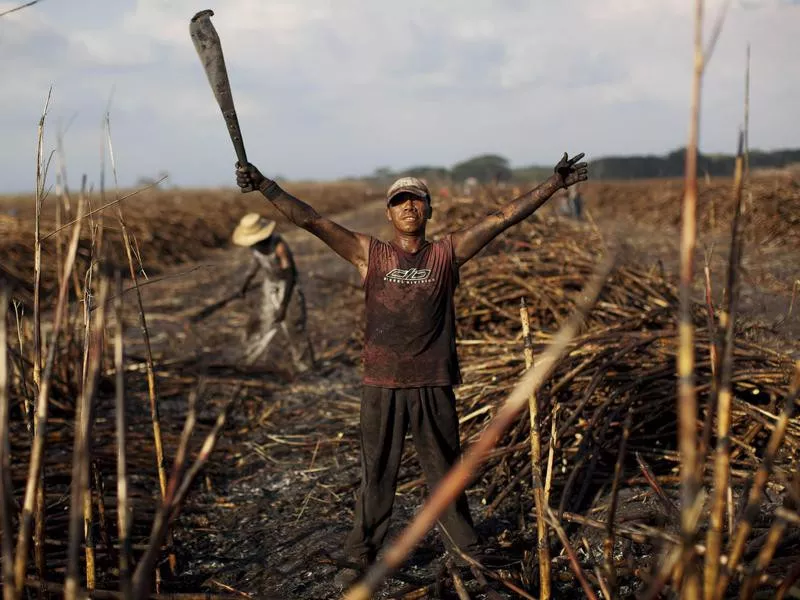
A sugarcane worker in a cane field near Retalhuleu, Guatemala. Rodrigo Abd / AP Photo
Sugar has a bloody history, and in some parts of the world, the life of a sugar farmer is still deadly.
In a Nicaragua town, three to four citizens die each day, and those deaths are linked to the hazardous working conditions of sugarcane harvesting for a local rum manufacturing plant.
If you’re concerned about where your sugar or sugary products came from, look for the Fair Trade Certified sticker.
16. Milk
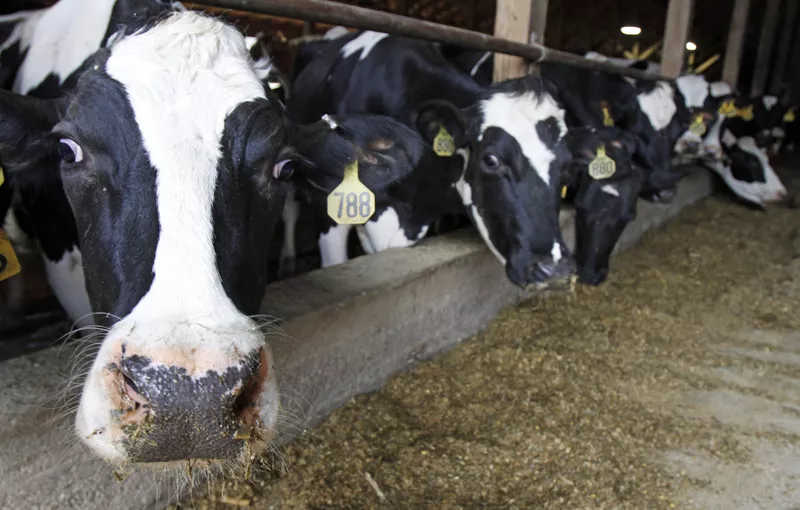
Cows in a barn in Fairfield, Vermont. Toby Talbot / AP Photo
GHG emissions: 3.0 kgCO2e
Type of food: Dairy
Biggest producers: Europe, United States and India
Avg. price: About $3 for a gallon
Historical origin: Evidence suggests dairying first occurred in Europe 6,000 years ago. Scientists believe these ancients slowly gained the ability to drink milk (without horrible diarrhea in those pre-pasteurizing days) through the spread of a genetic mutation called lactase persistence.
Did you know: Approximately 270 million dairy cows feed the world’s demand for milk.
Bottom Line for Milk
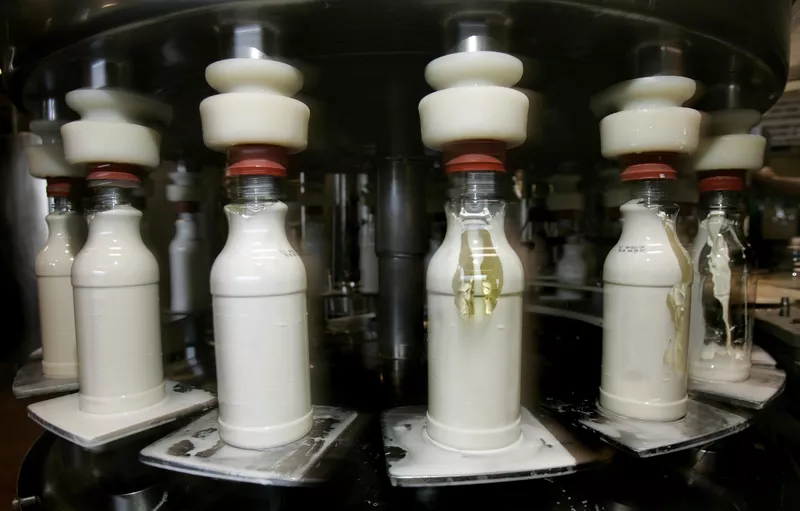
Milk is bottled at a dairy in West Valley City, Utah. Douglas C. Pizac / AP Photoo
Methane production is the chief cause of milk’s carbon footprint. But its footprint is surprisingly small compared to other animal-based agricultural practices.
15. Wild-Caught Fish

A fisherman carries a giant pike during a traditional fish haul at the Olsina pond near the village of Hodnov, Czech Republic. Petr David Josek / AP Photo
GHG emissions: 3.0 kgCO2e
Type of food: Seafood
Biggest producers (by capture): China and Indonesia
Avg. price: Varies depending on location and type of fish
Historical origin: Evidence of fishing may date back to the Pleistocene era. Archeologists have found evidence that our ancestors fished 500,000 years ago.
Did you know: China caught approximately 15.37 million metric tons of fish in 2017. That year, Indonesia, India and the United States caught about 17 million metric tons combined.
Bottom Line for Wild-Caught Fish

Fishermen work to unload a net full of anchovies during a fishing expedition in the Pacific Ocean, off the coast of El Callao, Peru. Rodrigo Abd / AP
In this study, emissions measured for wild fish refers to the fuel use by fishing vessels. It doesn’t take into account the serious problem of overfishing, something that China is notorious for.
The country has overfished its waters so badly that it has resorted to illegal practices and fishing within other nation’s economic zones.
14. Rice
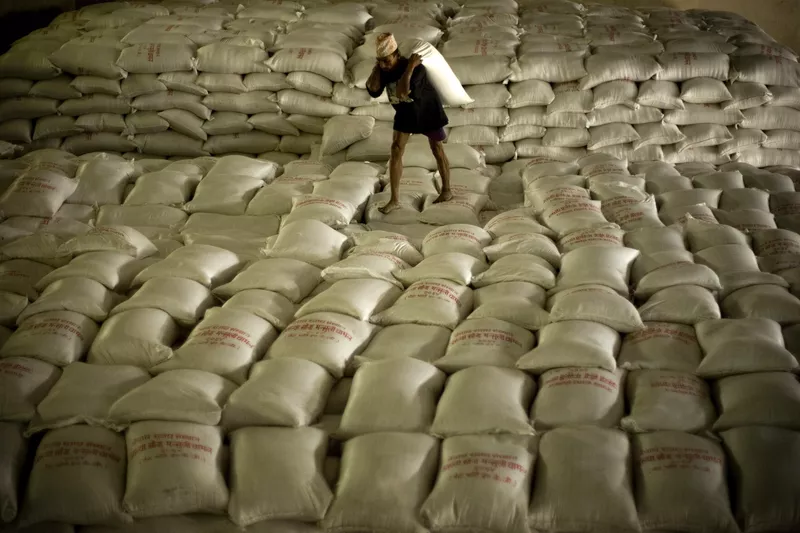
A Nepalese worker carries a sack of rice in a government warehouse in Katmandu, Nepal. Emilio Morenatti / AP Photo
GHG emissions: 4.0 kgCO2e
Type of food: Grain
Biggest producers: China and India
Avg. price for a pound of rice: $0.71
Historical origin: The earliest evidence of rice domestication dates back to 7000-5000 B.C. in China.
Did you know: Rice is one of the world’s most important crop, especially in the developing world. Half of the world depends on it.
Bottom Line for Rice
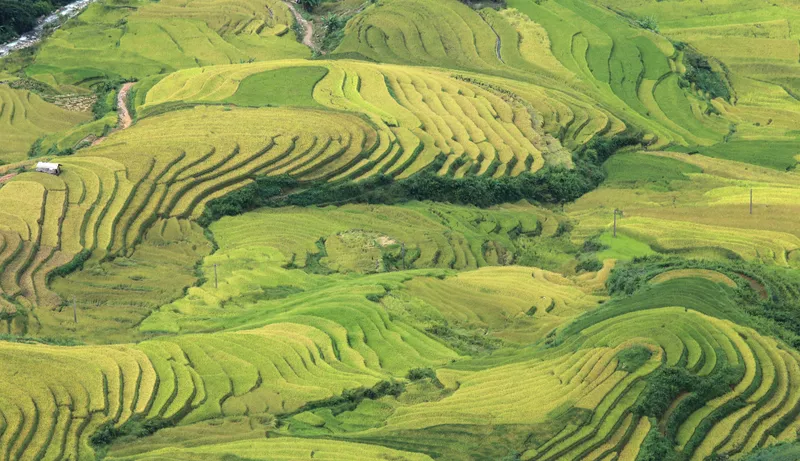
Terraced rice fields are seen from a mountain pass in the Mu Cang Chai district of the Yen Bai province in Vietnam. Hau Dinh / AP Photo
Rice doesn’t fart, but flooded rice fields produce methane, which makes up the bulk of its carbon footprint.
However, its carbon footprint isn’t too bad considering how much of the world depends on the grain.
13. Eggs
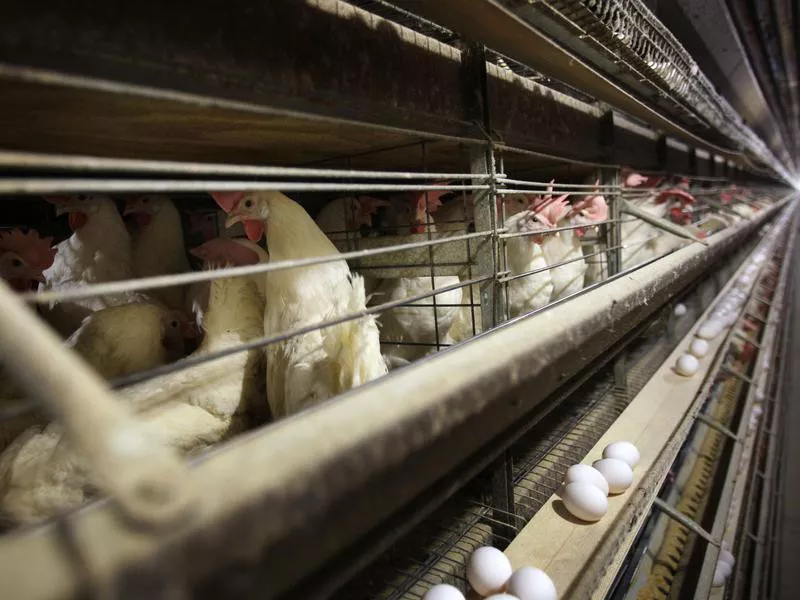
Chickens stand in their cages at a farm near Stuart, Iowa. Charlie Neibergall / AP Photo
GHG emissions: 4.5 kgCO2e
Type of food: Protein
Biggest producers: China and United States
Avg. price for a dozen eggs: $1.58
Historical origin: Evidence found in East India suggests people ate the eggs from wild jungle fowl around 3200 B.C., although only sometimes. Usually, they kept the eggs to hatch more birds, which they ate.
Did you know: China produces almost as many eggs as the other nine leading egg-producing nations. The country produced 458 billion eggs in 2018 — more than one billion eggs a day. The United States, the world’s second-leading egg producer, produced 109 billion.
One massive Chinese hatching farm, which is almost entirely automated, hatches 400,000 chicks per day. A video of that is here, and although there’s nothing violent in the video, animal lovers may want to skip the click.
Bottom Line for Eggs
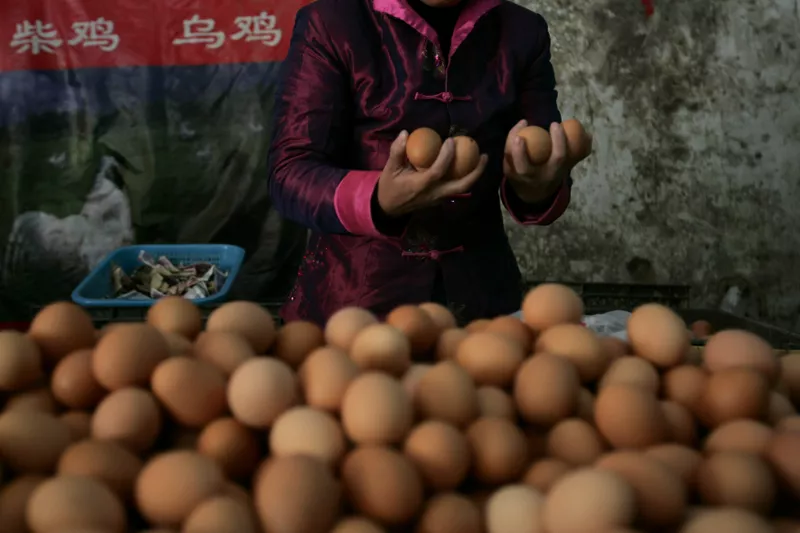
A shopkeeper sells chicken eggs at a market in Beijing, China. Elizabeth Dalziel / AP Photo
Eggs are a cheap and protein-rich food that’s vital to certain countries. An egg’s carbon footprint consists mostly of the farm emissions from crop production used to feed the hens.
Hens that are cage-free may lead happier lives, but cage-free eggs aren’t more sustainable for the planet than those in the coop.
12. Farmed Fish
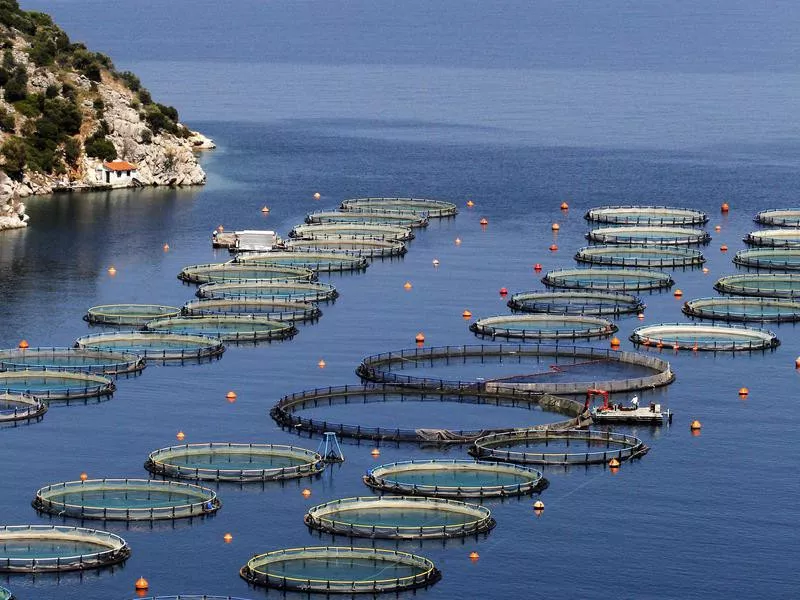
Fish-farming facilities on the coast near Epidaurus in Greece's southern Peloponnese region of Corfos. Dimitri Messinis / AP Photo
GHG emissions: 5.0 kgCO2e
Type of food: Seafood
Biggest producers: China
Avg. price: Varies wildly depending on location and type of fish
Historical origin: There is some evidence that the first aquaculture developments occurred as far back as 2000 B.C. in China. The first written record of aquaculture dates back to around 500 B.C. and appears in a Chinese book called "The Classic of Fish Culture."
Did you know: Fish farming has skyrocketed over the last 20-plus years. In 1996, the world was producing 33.79 billion metric tons of farmed fish, mollusks crustaceans and plants. By 2015 — the latest data available from the World Bank — that number increased to over 106 billion.
Bottom Line for Farmed Fish

A man urges catfish fingerlings into a loading net at the Quiver River Aquaculture catfish farm in Moorhead, Mississippi. Rogelio V. Solis / AP Photo
China again takes the lead here, as it requires unfathomable amounts of food for its 1.4 billion people.
And there’s some good news about fish farming — fish populations can be monitored, and the feed conversation ratio of fish is 1:1. Meaning one pound of feed produces one pound of fish protein, according to the Aqua Culture Alliance.
11. Olive Oil
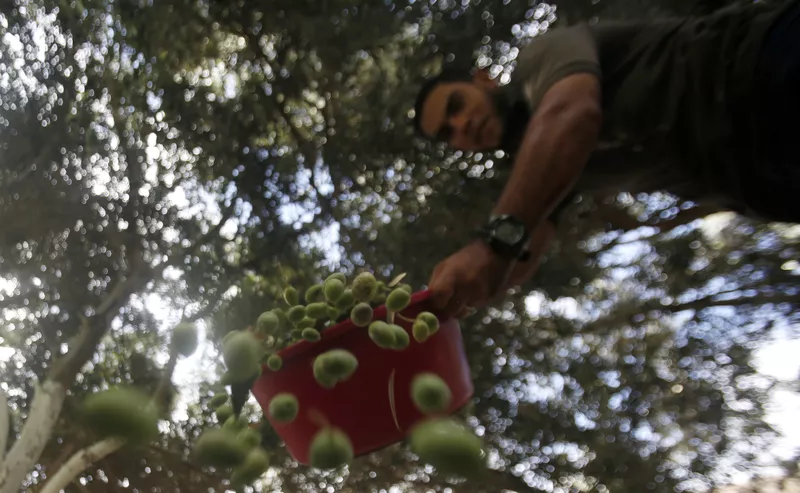
A Palestinian farmer removes leafs from the picked olives during the harvest season in Gaza City. Hatem Moussa / AP Photo
GHG emissions: 6.0 kgCO2e
Type of food: Oil
Biggest producers: Spain, Italy, Greece, Turkey and Tunisia
Avg. price: The price varies from the single figures for a generic bottle to $185 for a liter of ultra-expensive Lambda olive oil.
Historical origin: Olives were domesticated 6,000 years ago in the Mediterranean basin, but actual production of olive oil — squeezing the oil from olives — dates back to 2500 B.C. It was first used for lamp fuel and religious ceremonies, according to Thought Co.
Did you know: The ancient Egyptians used olive oil "as a cleanser, moisturizer and antibacterial agent for centuries," according to The New York Times.
Bottom Line for Olive Oil

A worker uses an electric comb to harvest frantoio olives in the Pagliatura estate in Magliano, central Italy. Domenico Stinellis / AP Photo
According to this study, the majority of carbon emissions emitted as a result of olive oil farming come from the machinery used to collect and squeeze the olives (the process is pretty fascinating).
On the bright side, olive oil trees are an excellent carbon sink, which is why their land-use change factor is a net positive.
10. Poultry Meat
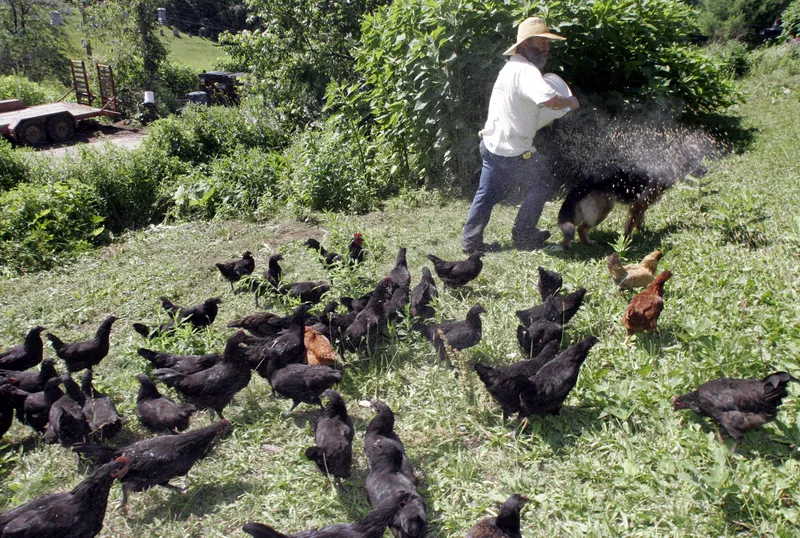
A man spreads grain for his chickens at his farm in East Montpelier, Vermont. Toby Talbot / AP Photo
GHG emissions: 6 kgCO2e
Type of food: Poultry
Biggest producers: China, Indonesia and United States
Avg. price: About $3 for a pound of boneless chicken breast.
Historical origin: Was it the chicken or the egg? As we wrote about in the origin of egg eating, fowl consumption and domestication date back to 3200 B.C. But according to Smithsonian Magazine, the earliest signs that man ate actual chickens, not just generic fowl, date back to 400 B.C. But then another article, also published by the Smithsonian, says that chickens were eaten in the Fertile Crescent sometime around 1,000 B.C.
Did you know: In 2018, there were over 5.27 billion chickens living in China.
Bottom Line for Poultry Meat

Tandoori roast chicken in Concord, New Hampshire. J.M. Hirsch / AP Photo
Chickens don’t produce methane, which reduces its carbon emissions.
The majority of its carbon footprint comes from land-use change and animal feed, according to this study.
If you don’t want to give up meat, fish and chicken are the next best things to eat.
9. Pig Meat
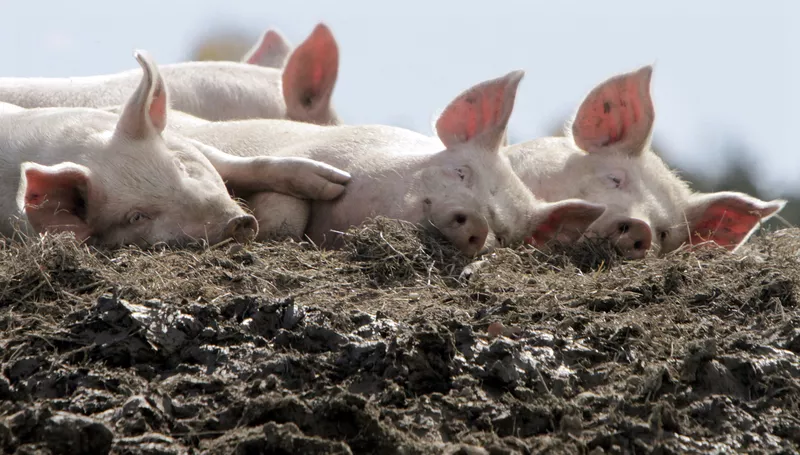
A group of pigs relax in the afternoon sun in their pen at a farm in Berlin, Vermont. Toby Talbot / AP Photo
GHG emissions: 7 kgCO2e
Type of food: Pork
Biggest producers: China, European Union and United States
Avg. price: $3.78 for a pound of bone-in pork chops.
Historical origin: Humans domesticated pigs in the Fertile Crescent between 5,000 and 2,000 B.C. According to Richard W. Redding, an anthropology professor, pigs were a popular source of food until man discovered the chicken, which was easier to care for.
Did you know: In China, thousands of pigs are stored in 13-story buildings that can house 1,000 pigs per floor. They’re known as hog hotels. It’s one somewhat new housing solution for China’s 440.6 million pigs.
Bottom Line for Pig Meat
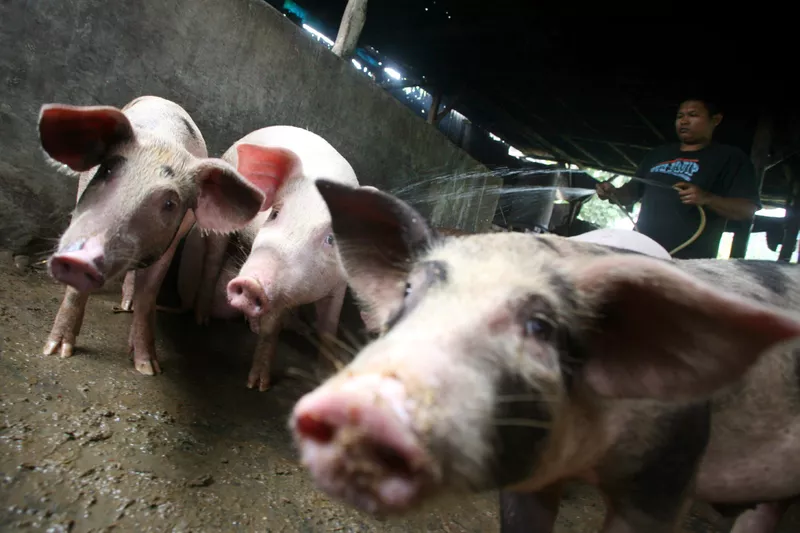
A farmer washes pigs at a pig farm in Medan, North Sumatra, Indonesia. Binsar Bakkara / AP Photo
The carbon footprint from pig farming mostly comes from crop production necessary to feed the livestock.
Pigs do produce methane, although it’s not too significant when compared to livestock like cows.
Most of that methane comes from the breakdown of manure — pig farms produced 0.34 percent of all animal agriculture emissions in the U.S. in 2014.
8. Palm Oil
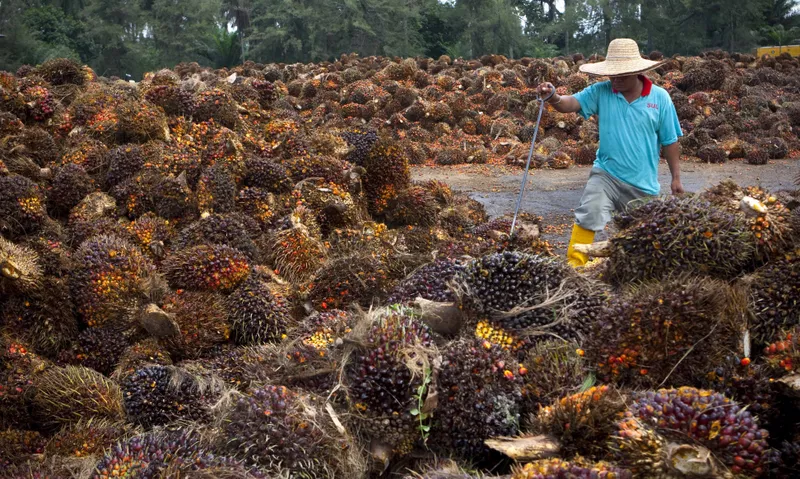
A worker collects oil palm fruits at a collection center in Dangkil, outside Kuala Lumpur. Vincent Thian / AP Photo
GHG emissions: 8 kgCO2e
Type of food: Vegetable oil
Biggest producers: Indonesia and Malaysia
Avg. price: While most palm oil is used in many different products, a 16-oz jar of organic red palm oil can be found at Walmart for $12.89.
Historical origin: Palm oil dates back to 3000 B.C. Egypt, where several kilograms of the substance were found in a tomb.
Did you know: Half of the palm oil imported by the European Union is used for biofuel.
Bottom Line for Palm Oil
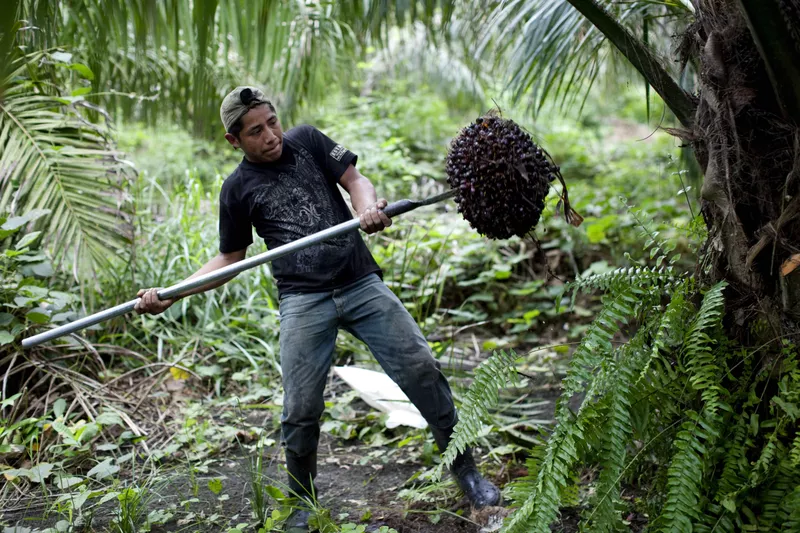
A plantation worker loosens away a fruit bunch from an African oil palm at a farm in Sayaxche, Guatemala. Rodrigo Abd / AP Photo
Clearing the path for more oil palm trees frequently means a slash-and-burn method of deforestation, which releases more carbon emissions.
This is something Western nations and the United States didn’t think about when they started promoting environmental laws that encouraged the use of vegetable oil as a new fuel. Deforestation caused by palm oil farming is also a serious threat to the orangutan population.
Land disputes in Indonesia between palm oil producers and local people aren't unheard of, either — in 2019, an Indonesian palm oil executive ordered the killing of two journalists who were advocating for locals involved in a land dispute with his company.
7. Farmed Shrimp
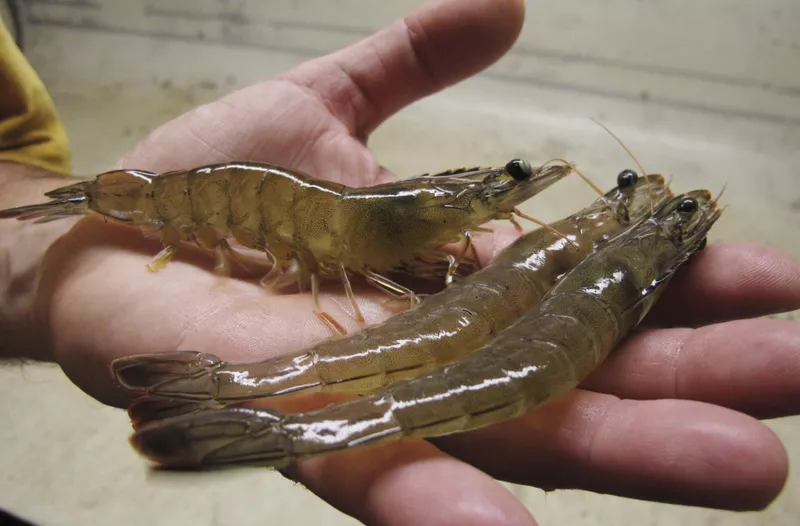
Some Pacific white shrimp that are raised at a farm in Fowler, Indiana. Rick Callahan / AP Photo
GHG emissions: 12 kgCO2e
Type of food: Seafood
Biggest producers: Thailand and China
Avg. price: While it varies by location for fresh shrimp — Gulf shrimp in Louisiana can be had for $4 or $5 a pound, for example — frozen shrimp is ubiquitous. At Walmart, 12 ounces of frozen shrimp from Vietnam will run you $5.34. Or you could buy two pounds of "fresh jumbo shrimp" on Amazon for $60, plus $47 in shipping.
Historical origin: Shrimp cultivation dates back to at least the 7th century, as it and other seafood were staples in the Chinese diet.
Did you know: Shrimp is the most popular seafood in the U.S., with an average of 4.1 pounds of shrimp eaten per capita.
Bottom Line for Farmed Shrimp

A Vietnamese worker treats the water at a shrimp pond with lime powder in Ca Mau in southern Vietnam. Richard Vogel / AP Photo
Shrimp farms not only release a surprising amount of CO2, but they pose a threat to the world’s mangroves. According to a 2012 report by the United Nations, a fifth of all mangroves have been wiped out to make way for shrimp and fish farms.
6. Coffee
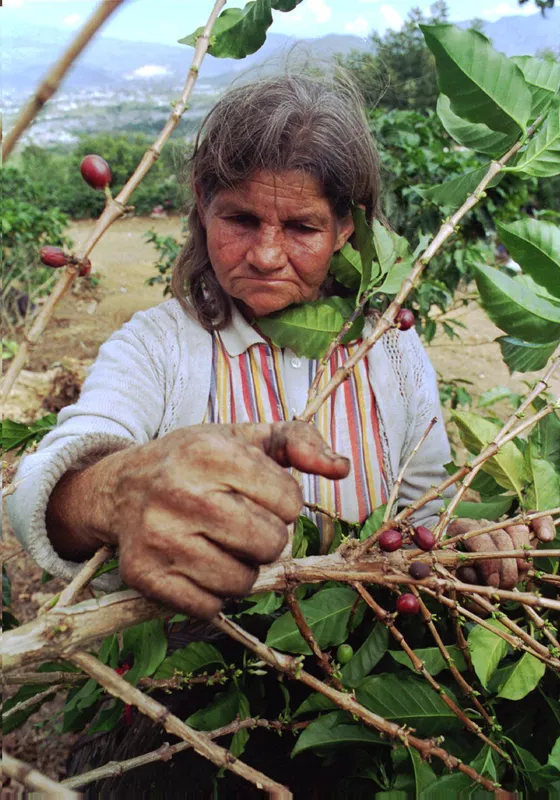
A woman strips the ripe coffee beans from a plant in the mountains above San Jose, Costa Rica. Kent Gilbert / AP Photo
GHG emissions: 17 kgCO2e
Type of food: Bean
Biggest producers: Brazil, Vietnam and Columbia
Avg. price: As any coffee drinker knows, it varies. You can pay $7 for a 24.2-ounce tub of Folgers at Walmart or $10 for a bag of ethically-sourced beans from the higher shelf. On average, one pound of coffee costs $4.17, according to the Bureau of Labor Statistics.
Historical origin: Coffee dates back to at least the 15th century, where it was cultivated and traded on the Arabian Peninsula. It’s probable that coffee was cultivated before then, but it’s disputed whether the bean was found in Ethiopia or Yemen. According to the Spruce Eats, Ethiopians consumed coffee in porridge-like form in the 10th century.
Did you know: Coffee’s origin is steeped in legend. According to one telling, an Ethiopian goat herder named Kaldi discovered coffee after he noticed his goats snacking on the bean and subsequently not sleeping. He then revealed the bean to a local abbot, who made a drink with it and used the energizing effects to stay awake during evening prayer, according to the National Coffee Association.
Bottom Line for Coffee

The Klatch Coffee shop in San Francisco, California, called this cup of Elida Natural Geisha coffee the world's most expensive coffee — at $75 a cup. Jeff Chiu / AP Photo
Coffee’s carbon footprint mainly comes from and fertilizers used to grow the bean.
The good news — coffee farms that implement additional crops like pepper and avocado to grow alongside their coffee trees create carbon sinks.
Transportation accounts for a significant amount of coffee emissions.
5. Chocolate
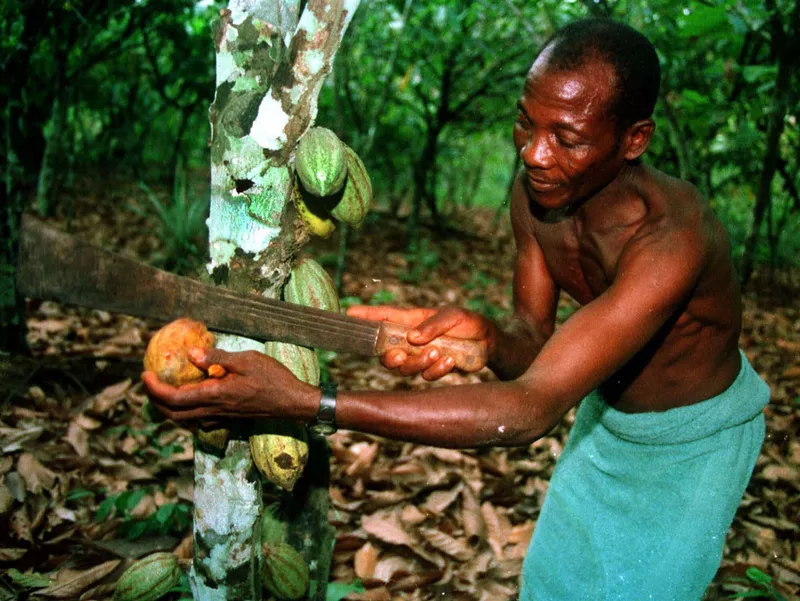
A man harvests a pod of cocoa beans from his plantation near the village of Baba in the southern rainforests of Ivory Coast. Clement Ntaye / AP Photo
GHG emissions: 19 kgCO2e
Type of food: Specialty
Biggest producers: United States, Germany, Switzerland and Belgium
Avg. price: A single Hershey’s bar from a retailer like Target costs $1.
Historical origin: The earliest evidence of chocolate domestication dates back three millennia to the Olmecs.
Did you know: While Western countries are the biggest producers of chocolate, 70 percent of the world’s cocoa beans come from Africa. Specifically, the Ivory Coast, Ghana, Nigeria and Cameroon. Ninety percent of all cocoa is grown on small family farms.
Bottom Line for Chocolate

A worker makes chocolate at the Scharffen Berger chocolate factory in Berkeley, California. Noah Berger / AP Photo
Most of the emissions from chocolate cultivation come from land-use change, and some of the environmental problems from chocolate farming are soil erosion and rainforest deforestation. Furthermore, since these farms are mostly located in developing countries, working conditions can be dangerous and exploitative.
To cut down on costs, some cocoa farmers may hire children to work or not provide their employees with adequate clothing or protection from dangerous pesticides, according to Make Chocolate Fair.
Look for Fair Trade, Utz Certified, Rainforest Alliance and other certifications on your chocolate to make sure they’re ethically sourced.
4. Dairy Herd Beef
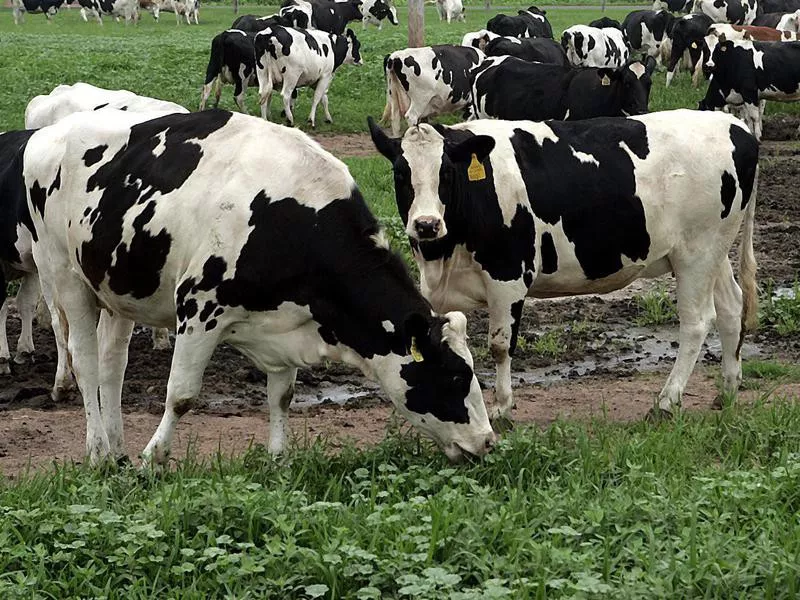
A small group of the more than 1,100 dairy cows that make up the herd at Oakridge Farms in Ellington, Connecticut, graze in a field at the farm. Bob Child / AP Photo
GHG emissions: 21 kgCO2e
Type of food: Beef
Biggest producers: India, European Union and Brazil have the largest number of milk cows.
Avg. price: Ground chuck, which is more likely to come from dairy cows than beef cows, goes for about $4 per pound.
Historical origin: Holstein cows — those spotted black and white (or red and white) cattle synonymous with American dairying — originated from the Netherlands about 2,000 years ago.
Did you know: In the United States, 15 percent of beef comes from dairy cows.
Bottom Line for Dairy Herd Beef
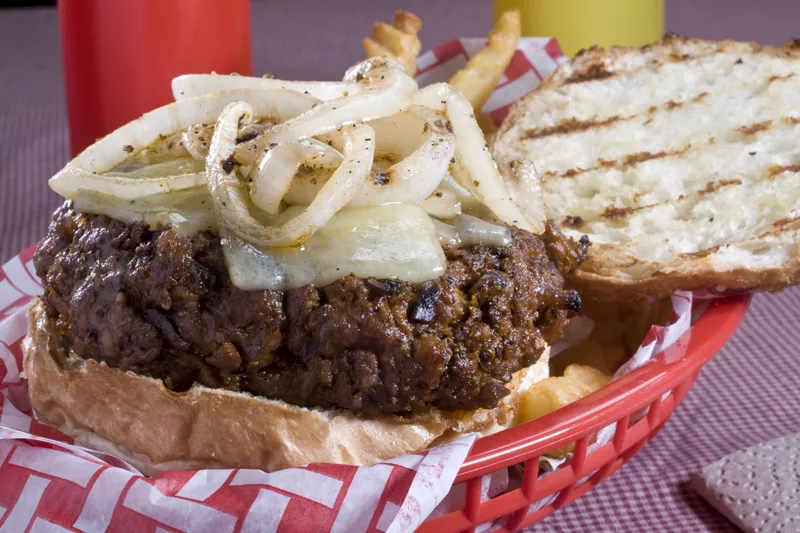
Barbecue gurus say the right meat, and particularly the right fat ratio, is what makes a burger successful. Larry Crowe / AP Photo
Beef that comes from dairy cows has a lower carbon footprint, the study reports, because they’re working double duty, while not being raised primarily just for slaughter.
According to Taste, a single beef cow produces 600 pounds of meat. But the dairy cow can produce "about 80,000 pounds of food in total, including milk, cream, butter, and beef."
You won’t find prime chops from these cattle, though. Taste says dairy cows are typically turned into hamburger meat, stew meat and animal food because of their leaner frames.
3. Cheese

Buffalo mozzarella cheese is prepared at a dairy in Caserta, near Naples, Italy. Franco Castano' / AP Photo
GHG emissions: 21 kgCO2e
Type of food: Dairy
Biggest producers: European Union and United States
Avg. price: A pound of cheddar cheese goes for an average of $5.20.
Historical origin: We don’t know who made the first cheese, but records indicate cheesemaking dates back over 4,000 years, to the time of ancient Egypt. Cheesemaking symbols have been found on ancient tombs.
Did you know: Italian cheese is the new reigning cheese champ of America. Italian cheeses, especially mozzarella, have overtaken American cheeses in popularity, a trend that experts say is attributable to our gluttonous love of pizza.
Bottom Line for Cheese
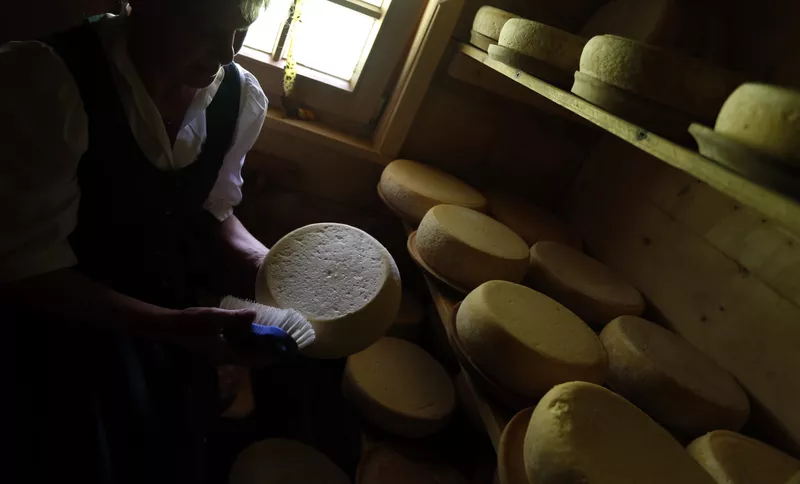
A farmer brushes a wheel of cheese at an alpine dairy near Berchtesgaden in southern Germany. Matthias Schrader / AP Photo
It might seem a little strange that cheese has a much larger carbon footprint than milk.
But that’s because it takes about 10 pounds of milk for a pound of hard cheese, according to Grist, citing Kari Hamerschlag, an analyst who authored another report on carbon footprints.
For those who don’t want to give up the cheese but want a more sustainable option, Hamerschlag says to buy local from farms that have "well-managed, grass-fed systems."
2. Lamb and Mutton
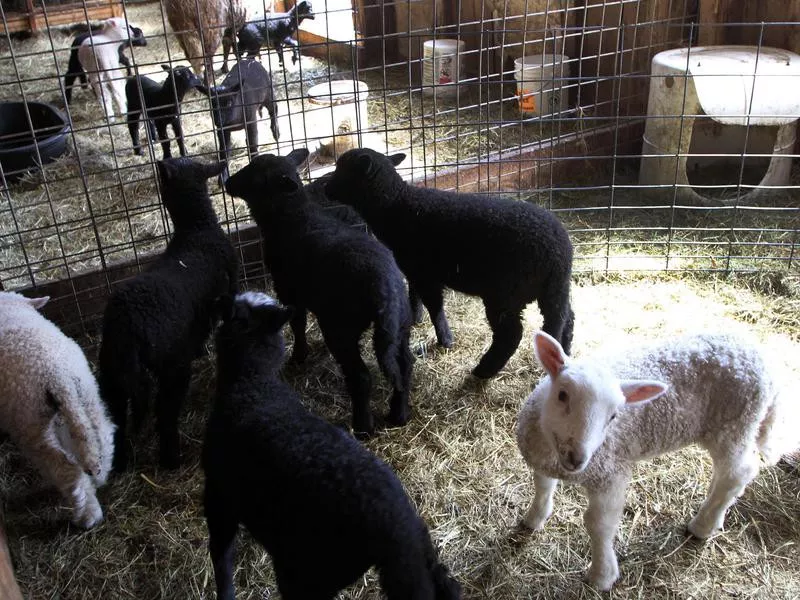
A flock of newborn lambs at a farm in Epping, New Hampshire. Jim Cole / AP Photo
GHG emissions: 24 kgCO2e
Type of food: Meat
Biggest producers: China, Australia and New Zealand
Avg. price for a pound of lamb chops: $10.59
Historical origin: Sheep were one of the first farmed animals, and eating lamb dates back 10,000 years, according to The Spruce Eats.
Did you know: Lamb, or sheep that are under the age of 1, accounts for about 6 percent of the world's meat consumption. China is the top consumer and importer of sheep meat. Mutton, sheep that are older than 1, tends to be harvested at about 3 years old and is most popular in the Middle East and Europe, according to Kitchn.
Bottom Line for Lamb and Mutton
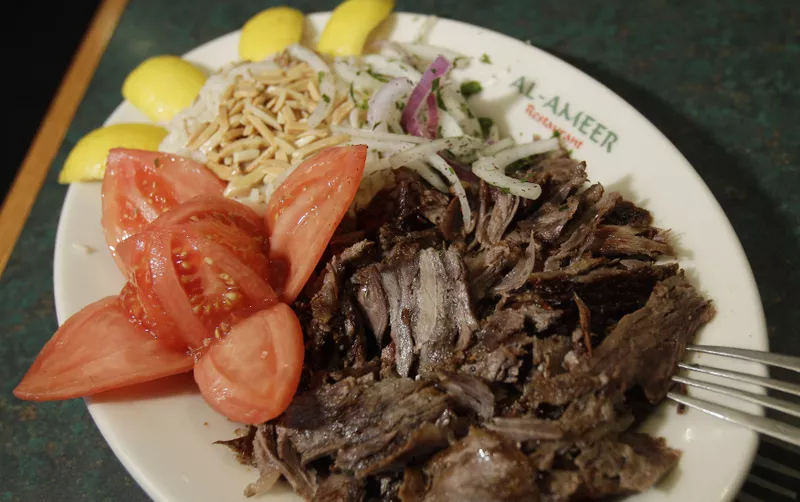
A lamb shawarma dish is shown at a restaurant in Dearborn, Michigan. Carlos Osorio / AP Photo
Farm factors and animal feed account for much of lamb and mutton's carbon footprint, likely because many sheep are farmed outdoors, though some are fattened indoors. According to Compassion in World Farming, the main welfare concerns for sheep and lamb come from mutilations, lameness, long-distance transport and disease.
Because of the ethical dilemma of lamb eating, lamb consumption in the U.S. has been dropping since the 1960s. Back then, Americans per capita consumed five pounds. Today, that number has been at about one pound for the past 10 years. Consumption rises around the holidays of Easter and Christmas, but the American Lamb Board wants to increase demand 10 percent by 2022.
If you plan to buy lamb, look for "grass fed" or "access to pasture" on the label.
1. Beef from Beef Herds
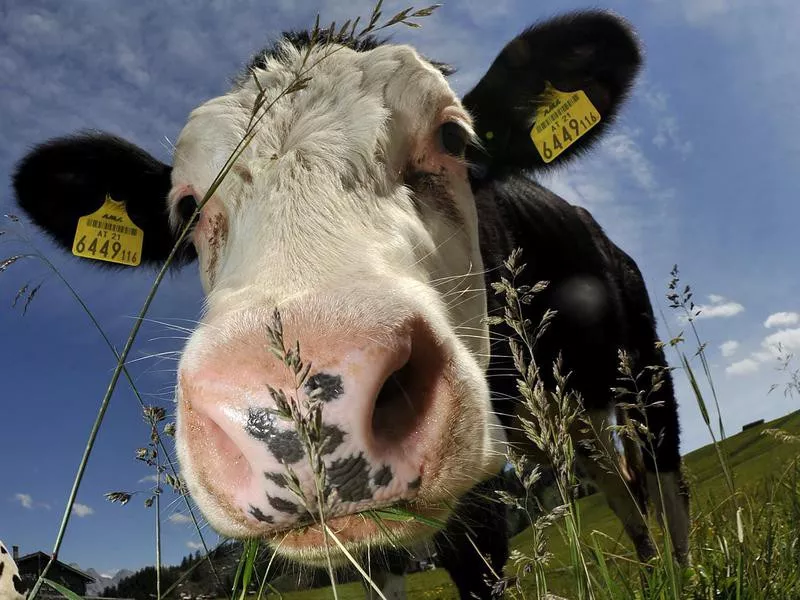
A cow grazes on the Loferer Alm countryside, near Lofer, in the Austrian province of Salzburg. Kerstin Joensson / AP
GHG emissions: 60 kgCO2e
Type of food: Meat
Biggest producers: United States, Brazil, European Union and China
Avg. price for a pound of ground beef: $3.88
Historical origin: The earliest traces of cattle domestication date back 10,500 years ago. Our ancestors domesticated aurochs, extinct wild oxen from which cattle is descended.
Did you know: The oldest animal drawing in the world, discovered in 2018, depicts a cattle-like animal. However, it’s not clear that the 40,000-year-old drawing suggests that early man hunted the beast.
Bottom Line for Beef From Beef Herds
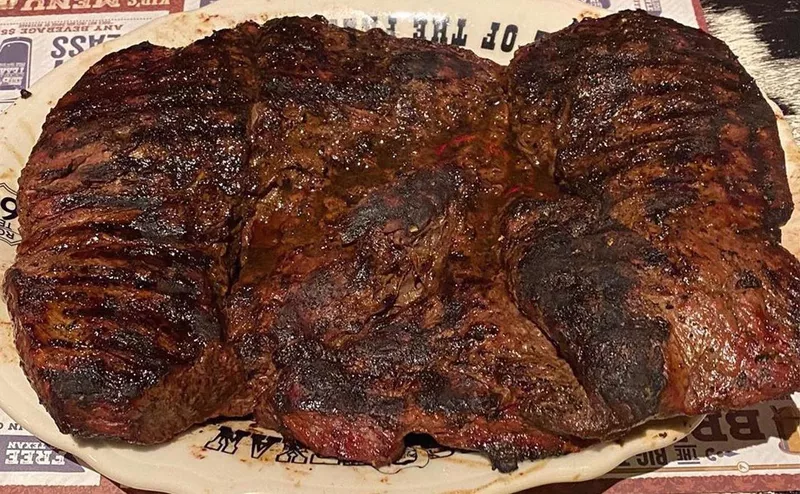
The Checkdown / Facebook
Beef is absolutely the worst and most unsustainable food available. Cattle have an enormous carbon footprint because of their methane emissions — which mostly comes from their burps, not farts.
The United States is the largest producer of beef in the world, producing 12.7 million metric tons of beef in 2019. But arguably the most problematic beef producer is in second place: Brazil. Cattle ranching in the Amazon accounts for 80 percent of all deforestation in the area, according to Yale’s Global Forest Atlas. This deforestation is almost always done slash-and-burn style, which can take centuries to recover — and the recent Amazon fires have been linked to the slash-and-burn method.
While the Our World in Data study found that transportation is pretty insignificant cause for emissions in beef farming — and the farming of all foods on this list — the reasons for buying locally are more important than just CO2.
